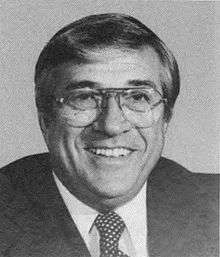William Louis Dickinson
| William Louis "Bill" Dickinson | |
|---|---|
 | |
| Member of the U.S. House of Representatives from Alabama's 2nd district | |
|
In office January 3, 1965 – January 3, 1993 | |
| Preceded by | George M. Grant |
| Succeeded by | Terry Everett |
| Personal details | |
| Born |
June 5, 1925 Opelika, Lee County, Alabama, USA |
| Died |
March 31, 2008 (aged 82) Montgomery, Alabama |
| Political party | Republican |
| Alma mater | University of Alabama Law School |
| Occupation | Attorney |
| Military service | |
| Service/branch | United States Navy |
| Battles/wars | European Theatre of World War II |
William Louis "Bill" Dickinson (June 5, 1925 – March 31, 2008), was a Republican Representative from Alabama's 2nd congressional district from 1965 to 1993.
Early life
Dickinson was born in Opelika in Lee County, Alabama. He served in the United States Navy during World War II in the European Theater. After returning from the war, he graduated from the University of Alabama School of Law in Tuscaloosa.
Dickinson practiced law for two years before being elected as a Democrat as a Lee County judge. In 1958, he was elevated to the position of state judge, from which he resigned in 1962. He then worked as an executive for the Southern Railway.
Political career
In 1964, he ran for Congress as a Republican in the 2nd District, which was anchored by Montgomery and included most of the southeastern portion of the state. He defeated 14-term incumbent Democrat George M. Grant by a shocking 25-point margin. Almost none of the district's living residents had been represented by a Republican before, and Dickinson was the first Republican to challenge Grant. However, as was the case in most of Alabama, most of the 2nd District's voters turned against the Democrats when U.S. President Lyndon B. Johnson signed the Civil Rights Act of 1964. Dickinson was also the beneficiary of long coattails from Barry Goldwater, who carried many of the counties in the district by staggering margins (well over 70% in most cases).
Joining Dickinson in victory in four other House races were Jack Edwards in the 1st District, John Hall Buchanan, Jr. in the 6th District, Glenn Andrews in the 4th District and James D. Martin in the 7th District.[1] That gave the Republicans, who had not elected anyone to the House from Alabama since 1901, a majority of the state's House delegation for the first time since Reconstruction.
Dickinson was reelected by 9% in 1966, when Democratic gubernatorial nominee Lurleen Burns Wallace (running as a stand-in for her husband) led her party's slate to statewide victory by easily defeating Martin. Dickinson was then reelected 12 times without substantive opposition.
Dickinson was an important figure in shaping national defense policies during the 1970s and 1980s. As he gained seniority, he became ranking member of the House Armed Services Committee; and was a leading member of his party's conservative wing. He never served in the majority during his entire 28-year House tenure. However, he became very popular in his district, gaining a reputation for strong constituent service. Still, Democrats continued to hold most of the district's seats in the state legislature and would continue to do so well into the 1990s.
In 1965, he made two speeches to Congress (on March 30 and April 27) claiming that civil rights marchers were engaged in alcohol abuse, bribery, and widespread sexual debauchery at the marches. Religious leaders present at the marches denied the charges, and local and national journalists were unable to substantiate his accounts. The allegations of segregation supporters were collected in Robert M. Mikell's pro-segregationist book Selma' (Charlotte, 1965).[2]
In 1990, Dickinson was re-elected by only 2.5% over state welfare commissioner Faye Baggiano, his first competitive contest since his initial run in 1964. The closeness of the race prompted Dickinson to decide against running for a 15th term in the 1992 elections even though redistricting made the district safer for him on paper by shifting most of his black constituents to the 7th District. He is the longest-serving Republican congressman in Alabama's history.
Death
Dickinson died at 82 of colon cancer at his home in Montgomery, Alabama.[3]
References
- ↑ Billy Hathorn, "James Douglas Martin and the Alabama Republican Resurgence," Gulf Coast Historical Review. Vol. 8, No. 2 (Spring 1993), p. 165
- ↑ Mikkel's book was published with a colorized photograph showing splotches of blood drawn in on Viola Liuzzo's car. See Jane Dailey. "Sex, Segregation, and the Sacred after Brown". The Journal of American History 91.1.
- ↑ Retired U.S. Rep. Dickinson dies, The Montgomery Advertiser, April 2, 2008
External links
- United States Congress. "William Louis Dickinson (id: D000326)". Biographical Directory of the United States Congress.
- Advantage Associates, Inc. biography
| United States House of Representatives | ||
|---|---|---|
| Preceded by George M. Grant |
Member of the U.S. House of Representatives from Alabama's 2nd congressional district 1965–1993 |
Succeeded by Terry Everett |